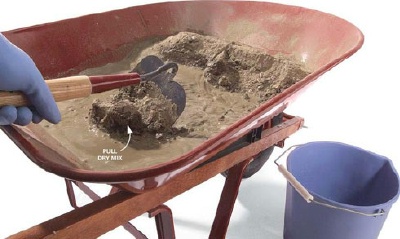 When making concrete it's important to use the correct concrete mixing ratios to produce a strong, durable concrete mix.
When making concrete it's important to use the correct concrete mixing ratios to produce a strong, durable concrete mix.
To make concrete there are four basic materials you need: portland cement, sand, aggregate (stone), and water. The ratio of aggregate to sand to cement is an important factor in determining the compressive strength of the concrete mixture.
A concrete mixture ratio of 1 part cement, 3 parts sand, and 3 parts aggregate will produce a concrete mix of approximately 3000 psi.
Mixing water with the cement, sand, and stone will form a paste that will bind the materials together until the mix hardens. The strength properties of the concrete are inversely proportional to the water/cement ratio.
First put in the water - around 7 litres (1½ gallons), using more or less depending on the type of mix required. Add some aggregate before adding cement, to avoid sticking. Work consistently to the ratio of ingredients for whatever type of concrete mix you are working to.
CONCRETE MIX RATIO
| |||
Mix Ratio
|
Grade
|
Use Area
|
Note
|
1:1:2
|
M - 25
|
High Strength area
| |
1:1.5:3
|
M - 20
|
For Column, Pile Cap, Shear Wall
|
With 3/4" down stone Chips +With Ratio of Sylhet Sand and Local Sand 2:1
|
1:2:3.5
|
M - 15
|
For Underground Water tank, Footing
|
With Ratio of Sylhet Sand and Local Sand 2:1
|
1:2:3.5
|
M - 15
|
For Floor Slab, Beam, Stair
|
With Ratio of Sylhet Sand and Local Sand 2:1
|
1:2:4
|
M - 15
|
For Lintel, Sunshade, False Ceiling
|
With brick Chips + Ratio of Sylhet Sand and Local Sand 2:1
|
1:3:6
|
M - 10
| ||
1:5:10
|
M- 5
| ||
| Mix | Batch quantities | Approx batch output (ltr) | |||
| Cement (50kg bag) | Sand (ltr) | Stone (ltr) | |||
| Most ordinary concrete | 1:2:4 | ½ bag | 35 | 70 | 85 |
| Foundations | 1:3:6 | 1/3 bag | 35 | 70 | 78 |
| Rough mass concrete | 1:4:8 | ¼ bag | 35 | 70 | 78 |
| Watertight floors, tanks, pits, etc | 1:1½:3 | 2/3 bag | 35 | 70 | 85 |
for 35 litres use approx 6 No 2 shovels; 1m3 = 1,000 litres
Getting a good mix
The approximate mixing time for concrete is 2-4 minutes from when all the material (including the water) has been added - over-mixing can reduce strength and cause segregation of the coarser aggregates.
Beware of low grade aggregates; these will only lead to trouble later on with sinking and frost spoiling the appearance of the pour.
Also do not get the concrete mix too wet as this can reduce strength and make it less able to withstand weathering.
Looking after your mixer
Never throw material into the mixer - trickle it steadily over the rim or it will stick firmly to the back of the drum and can only be dislodged by stopping the mixer.
Keep your mixer clean - material left in the drum will harden, and attract more on each use until the mixer is useless.
Do not throw bricks into a mixer drum to clean it out. The best method is a mix of 1" (2½cm) gravel and clean water - use plenty of it, as this will do the job in half the time.

Concrete Mix Ratio With Grade And Usage Area >>>>> Download Now
ReplyDelete>>>>> Download Full
Concrete Mix Ratio With Grade And Usage Area >>>>> Download LINK
>>>>> Download Now
Concrete Mix Ratio With Grade And Usage Area >>>>> Download Full
>>>>> Download LINK